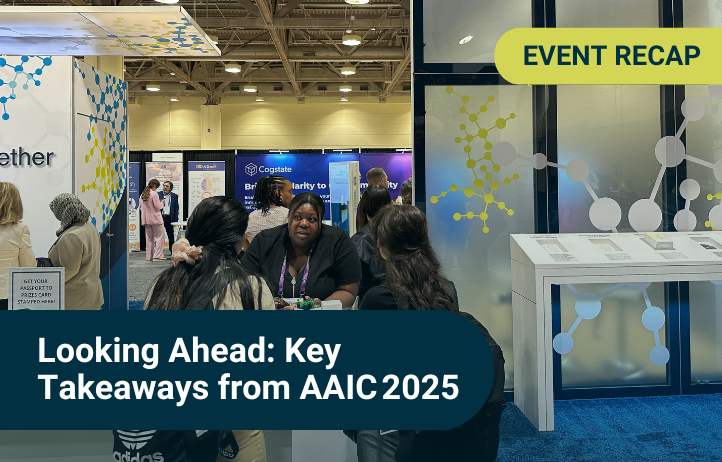
Looking Ahead: Key Takeaways from AAIC 2025
The 2025 Alzheimer’s Association International Conference (AAIC) brought the global neuroscience community to share breakthrough science, policy priorities, and tools like never before. It was an incredible week of conversation, innovation and inspiration.
Our team of experts including Jorge Marques Signes, VP of Accelerator Services, Mingwei Zhao, Senior Director of Accelerator Services and Lindsey Mette, Director of Diagnostic Medical Affairs attended dozens of talks and came away with several key highlights.
1. Rallying for research investment
The conference opened with an urgent call to action from Dr. Joanne Pike (CEO) and Dr. Maria Carrillo (CSO) of the Alzheimer’s Association. Their plea was clear: to sustain momentum, U.S. researchers and advocates must champion restoration of NIH and Alzheimer’s research funding. With major scientific advances underway, ongoing federal support is essential for translating discovery into patient impact.
2. We celebrated more than 50 years of tau science
A dedicated session commemorated 50 years of Tau science! The session was led by Dr. Michel Goedert, who traced tauopathy discoveries from molecular folding patterns to structural insights. Dr. Bess Frost followed with data on retrotransposon activation and suggested that repurposed antiviral therapies might serve as innovative tau-targeting strategies. We look forward to seeing more about this in the future!
3. Biomarkers: Precision in motion
Biomarkers anchored AAIC’s scientific narrative, with emphasis on multi-marker strategies and ultra-sensitive technologies like Simoa® that are powering new AI and diagnostic tools. Highlights included:
- Dr. Inge Verberk advocating for composite blood biomarker panels to increase diagnostic precision in dementia care.
- Dr. Kaj Blennow presenting on the distinctions between plasma and CSF tau markers—including new data on MTBR‑pTau262, which correlates strongly with neurodegeneration and tau PET.
- Exploration of emerging blood-based biomarkers for TDP‑43 and alpha-synuclein, particularly microRNA and EV-linked markers showing early promise.
4. Quanterix’s Bold Tau Innovations: “All Tau‑gether Now”
At AAIC 2025, Quanterix made headlines with the first-to-market launch of two novel tau phosphorylation assays: p‑Tau 205 and p‑Tau 212, now commercially available on the HD‑X and SR‑X.
- p‑Tau 212 rises early in tau pathology, capturing conformational changes that precede symptom onset—ideal for early trial enrollment and disease monitoring.
- p‑Tau 205 aligns with mid-to-late stage neurofibrillary tangle accumulation and cognitive decline, offering a powerful staging tool
Together, this expanded tau assay suite, which also includes p-Tau 217, p-Tau 181, p-Tau 231, Total Tau and BD-Tau enables a stage-aware, multi-analyte approach for both clinical trials and translational research.
5. Transforming Access with Remote Sampling
Decentralized diagnostic tools took center stage:
- DropAD demonstrated use of dried blood spots (DBS) for detecting p-Tau 217, GFAP, and NfL via Simoa, correlating strongly with conventional plasma results.
- Neurogen Biomarking showcased a remote capillary collection device yielding clinical-grade biomarker data, underscoring feasibility for global, home-based testing.
These innovations promise expanded access for underserved and global populations.
This week confirmed that the path forward in Alzheimer’s research is clear, and it depends on our ability to detect the undetectable, to see change before symptoms appear, to measure progress before it’s visible, and to act earlier than ever before. That’s why ultra-sensitivity matters. It’s what powers the breakthroughs in blood and tissue biomarkers, the validation of blood-based diagnostics, and the confidence to move from discovery into clinical utility.
At Quanterix, we’re proud to be a trusted partner in this transformation. With over 3,400 peer-reviewed publications and inclusion in more than 55 posters at AAIC 2025, our Simoa® technology continues to empower researchers across the globe with the sensitivity, reproducibility, and reliability needed to push the boundaries of what’s possible in neurodegeneration.
Ready to advance your research with Simoa ultra-sensitive biomarker technology? Learn more about our neurology solutions or connect with our team.